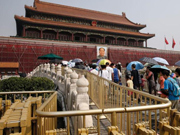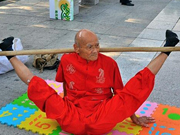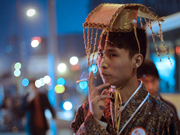 |
| On September 18, the Eighth Route Army reclaimed Mancheng County. (Photo/Second Historical Archives of China) |
The Japanese government responded to the Potsdam Declaration and declared that “the only thing to do is just kill it with silence (mokusatsu).” Thus, Chinese army and people launched full-scale counter-attacks against Japanese invaders. The Eighth Route Army, the New Fourth Army and the anti-Japanese guerrilla troops in south China launched massive attacks against Japanese-occupied towns and roads in North China, Central China and South China. On August 9, 1945, Mao Zedong made the declaration “The last battle against the Japanese invaders”, calling on the anti-Japanese forces in China to make massive attacks against Japanese invaders and coordinate with the military operations of the Soviet Union and other allies. He asked the Eighth Route Army, the New Fourth Army and other people’s army to launch massive attacks against the Japanese and puppet troops which cannot accept Japan’s surrender to China. On August 10, the Central Committee of the Communist Party of China gave instructions to make massive attacks against the Japanese-occupied cities and roads and take control of these cities and roads since the Soviet Union’s participation in China’s war against Japanese aggression. On August 10 and 11, the headquarters of the Eighth Route Army issued a series of orders to make massive attacks against Japanese invaders. The army and people in the liberated zones continued the war against Japanese army after V-J Day as Japanese army was still at war with Chinese army. The army and people in the liberated zones liberated 150 cities above the county level from August 11 to September 2.
 |

 World's top 10 fighters
World's top 10 fighters CRH stewards dance to crazy 'Little Apple' at railway station
CRH stewards dance to crazy 'Little Apple' at railway station Tiananmen Square to be decorated to embrace the National Day
Tiananmen Square to be decorated to embrace the National Day Sea world 3D subway train unveiled in Ningbo
Sea world 3D subway train unveiled in Ningbo Photos of China's Liaoning aircraft carrier under sunset
Photos of China's Liaoning aircraft carrier under sunset 300 'Pandas' shown in Beijing
300 'Pandas' shown in Beijing Kai Ko, Jaycee Chan and other celebrities arrested
for drug use in 2014
Kai Ko, Jaycee Chan and other celebrities arrested
for drug use in 2014 78 years old man with stunning skills
78 years old man with stunning skills More than 2,200 troops assemble in N China for Peace Mission-2014 drill
More than 2,200 troops assemble in N China for Peace Mission-2014 drill Time travel shows - a popular form of entertainment in China
Time travel shows - a popular form of entertainment in China
Day|Week|Month